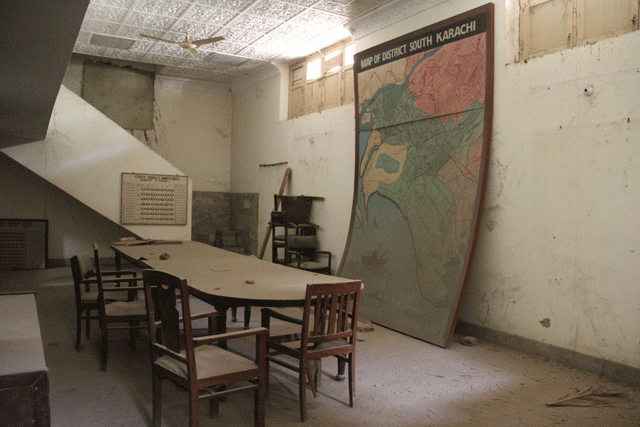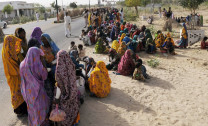Civil Defence’s Warning Operational Centre – then and now
Civilian organisations ‘ill-prepared’ for emergencies and calamities

A huge table in the middle of the CCRC room is surrounded by wooden chairs, all covered in dust. It speaks of how once the officials used to coordinate in a stressed environment while threats of attack loomed on the horizon. PHOTO: AYESHA MIR
He was speaking to The Express Tribune about the deteriorating condition of the Civil Defence’s Warning Operational Centre (WOC). According to him, the entire world has been upgrading this system and the Pakistan Air Force (PAF) has written to the government several times to upgrade their service. However, he says, the government does not pay heed.
According to him, Kargil war was the last time when the government thought about repairing the control room. However, nothing substantial happened even then, he lamented.
Purpose of the dept
The Civil Defence department falls under the federal and provincial governments’ interior and home ministries. The function of the department is to assist the armed forces during times of war or emergency by setting a communication setup between the armed forces and public.
Wither fire safety: Karachi at mercy of an ill-resourced emergency response system
During times of peace, the department is supposed to conduct basic training for awareness regarding fire fighting, casualty, rescue and warden services and air raid courses. It is also responsible for the inspection of fire safety of all the buildings in Sindh.
Sirens in wartime
Back in the day, the Civil Defence department’s WOC, situated in its headquarters in Garden, was used for sirens that used to blare whenever an Indian fighter plane would invade the port city or any other sort of threat emerged during the war.
"Blaring of air raid siren used to scare us,” says elderly Shahida Qazi while recalling the chronicles of the 1965 and 1971 wars. “We immediately used to turn off lights to hide ourselves in trenches or hideouts. The fire jets used to fly low over our houses and there used to be a complete blackout."
The sirens were installed at 72 different government buildings and also at a few petrol pumps of the port city after the formation of Civil Defence – formally known as Air Raid Precaution before Partition – in 1952.
Hung out to dry: No funds, equipment for Sindh’s civil defence
Forty-six years down the lane, while the military is fully prepared to tackle any foreign army invasion, the civilian department, which has a vital role to play during the wars in communication with the public, is in an apathetic state and needs some immediate attention.
A tour of the Warning Operation Centre
The control room, situated in the basement of the Civil Defence department’s headquarters, has remained closed for years. On a visit to the control room, huge cobwebs dangling from the roof and light fixtures – the only functional gadgets in the room – welcome you. Layers of dust have gathered on all the equipment and furniture around.
"The system has completely collapsed now," says an official of the department. He explains how their WOC had a very effective liaison network with the Pakistan Air Force's (PAF) Sector Air Command during the wars. The WOC, he says, used to comprise experts of the Civil Defence department. As soon as the PAF used to gauge any air intervention on its radars, they immediately used to inform the WOC. From the WOC, he says, the information used to be disseminated to the Combined Control and Report Centre (CCRC), where representatives of all the essential services and vital installations of the city used to be present round the clock in one room until the war ended.
As you enter the CCRC room, which is also situated in the basement of the Civil Defence headquarters, sunlight peeks through the small windows on the corner of the roof. A huge table in the middle surrounded by wooden chairs, all covered in dust, speak of how once the officials used to coordinate in a stressed environment while threats of attack loomed on the horizon.
In one corner lies a big map of the city. A board is attached to the wall, having name tags of all the essential services such as the Karachi Development Authority, Sui Southern Gas Company, Karachi Metropolitan Corporation and Karachi Water and Sewerage Board inscribed on it.
If any damage occurred due to war, the representatives of the essential services used to be informed through the WOC. Then and there, they used to dispatch their respective teams to the scene. Adjacent to the CCRC room, the control room is situated, where a huge mechanical board with lots of keys and small lights and considerably large telephone receiver are attached.
A small panel on the board covered with a dust-laden glass cover shows district-wise locations of the 72 sirens installed in the various parts of the city. While cleaning the glass with his finger, he shows that they have allotted the number ‘6’ for Liaquatabad in District Central. "If Liaquatabad was found under threat, they would turn number 6 switch on," he explains, adding that just above the switch, two small bulbs are attached. If green bulb lit, it meant the siren has started ringing. If the siren rings out with alternating low and high voices, it meant there is a chance of an attack, he says. If the siren rings in one tone, it meant the situation has normalised.
Sirens for Ramazan now
Over the passage of time, says the official, no war occurred after 1971 and they started using their siren services for announcing Sehr and Iftar times in the month of Ramazan. According to him, the control panel also has a master key, pressing which would ring out all the 72 sirens installed in the city, which helps them operate all the sirens at the same time across the city in Ramazan.
Also, he says, all the 72 sirens are made to blare simultaneously in the city on August 14 on the instructions of the federal government.



















COMMENTS
Comments are moderated and generally will be posted if they are on-topic and not abusive.
For more information, please see our Comments FAQ